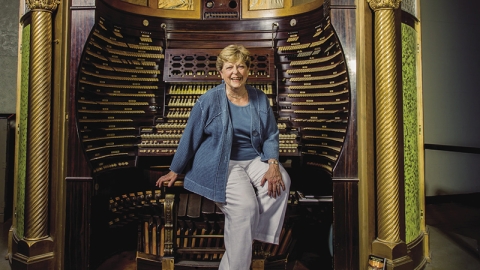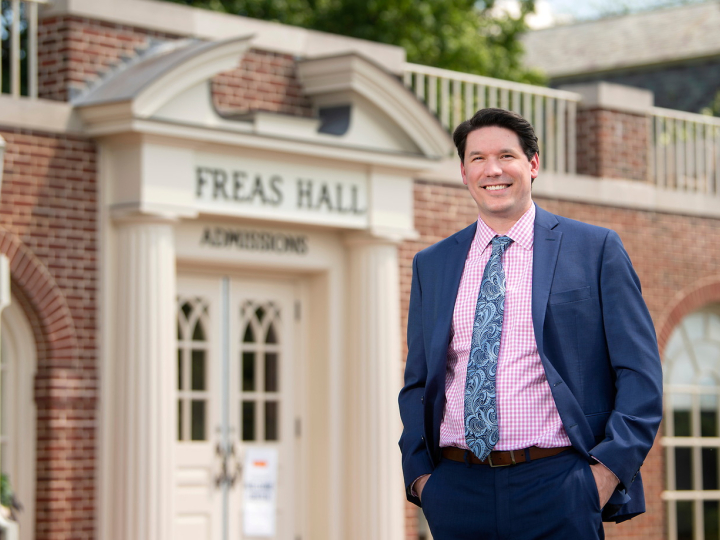
Pipe (Organ) Dreams
October 9, 2015
Billie Jane Boyer Maul '57 at Boardwalk Hall
Billie Jane Boyer Maul '57 pulls out all the stops to help make a mega-Atlantic City landmark roar again.
Thousands of tourists stroll the Atlantic City boardwalk each summer, unaware that hidden within the walls of an aging former convention center they pass by, in the shadow of the now-shuttered Trump Plaza casino, lurks perhaps the grandest piece of orchestral equipment ever assembled.
With more than 33,000 pipes — 20 to 30 times the number found in a typical church organ — the organ tucked inside Atlantic City’s original convention center, Boardwalk Hall, is the largest musical instrument in the world. Built during the Great Depression, this 150-ton wood-and-metal leviathan was severely damaged in a 1944 hurricane, beginning a long decline that would eventually silence it entirely. But the mighty Midmer-Losh organ is gearing up to roar once more, thanks to the efforts of volunteers such as Atlantic City native Billie Jane Boyer Maul ’57.
Maul, who now lives in nearby Margate, N.J., has early memories of Boardwalk Hall and its monumental sound system. As a child, she heard the organ at events like the 1946 Miss America Pageant and recalls ice-skating in the hall to bubbly organ tunes.
“Organ music is easy to ice skate to — it’s all one-two-three, one-two-three,” she says. “But then it died; there was no organ.”
Seven silent decades later, in June 2014, Maul was retired from her two careers — teaching and real estate. A state-organized committee had recently embarked in earnest on a 10-year, $16-million project to restore the Midmer-Losh to its former glory and begun offering daily tours of Boardwalk Hall. Maul took one and was so fascinated she asked volunteer Bob Parkhurst if there was a way she could help. His reply: “What are you doing tomorrow?” She came back the next day and has hardly left.
Maul joined a small but dedicated team of volunteers — most, like her, in their 70s and 80s — who have taken on the Sisyphean-seeming task of disassembling, cleaning, repairing and releathering the world’s largest organ, piece by piece.
Each of the organ’s 33,112 pipes is connected to a pressurized wind chest filled with leather-wrapped valves that open when a corresponding key is pressed, activated by electromagnetic relays. Each pipe — from pencil-thin flutes to one of only two 64-foot stops in the world — connects to between one and five or more leather valves. That leather has exhausted its 80-year life span and every inch, miles in all, must be replaced by hand, while the wood and metal also must be refurbished.
The damage began almost from the start. In 1944 the Great Atlantic Hurricane soaked Boardwalk Hall with 40 million gallons of seawater, drowning the organ’s blower motors — the lungs of the great beast — and rendering its electronic combination action — its brain — inoperable, as it remains today. After several months of drying out, the organ could safely be turned back on, but with a war raging across the Atlantic, materials weren’t available for proper repair.
It functioned fitfully for some years, but its condition declined. During building renovations, pipes were knocked around, moisture dripped from air conditioners, and the wire coils that formed the organ’s spine were sheared through. This organ seemed destined, like thousands of others, for the scrap heap.
Then, about a decade ago, the state of New Jersey chartered the Historic Organ Restoration Committee (HORC), providing $2 million to begin the decadelong task of restoring to full working condition the Midmer-Losh, as well as the Kimball pipe organ housed in the hall’s ballroom. The project began in earnest about two years ago, shortly before Maul joined the effort.
One afternoon this June, Maul and her co-workers are repairing the Kimball’s vibraharp, a percussion instrument similar to a xylophone connected to a series of wind-activated hammers that strike its keys in the manner of a piano. Each hammer is held in place by two strips of wood, and Maul is tediously scraping old felt from each and replacing it with a new strip. With her seemingly endless supply of energy, she devotes three days a week to organ restoration and tour guiding.
“I can’t believe at my age I have a real love for something like this, but I do,” she says. “I am behind this 100 percent. I love every minute that I’m here.”
The love Maul and others involved in the restoration feel for the organ is one shared by those who built the Midmer-Losh in the first place.
Entertaining the masses was in the DNA of Emerson Richards, a New Jersey state senator and attorney who wrote the contracts for the construction of the Holland Tunnel. Scion of a prominent family that became wealthy by devising a construction method for building on sand using sunken pilings (which enabled much of Atlantic City’s entertainment empire to exist on a barrier island), Richards owned several boardwalk bathhouses, where visitors could rent lockers and shower after a day at the beach, and he lived in a mansion with two pipe organs.
“He was an unbelievably grand man, and everything was easy for him,” says Curt Mangel, HORC president and curator of the Macy’s/Wanamaker Organ (the world’s second-largest instrument) in Philadelphia. “He was also a spoiled brat — you could see it in the way he carried himself. He knew he was good and had absolute self-confidence in everything he did.”
Richards secured state funding to build Boardwalk Hall, America’s first modern convention center, dedicated in 1929. (Local funding was obtained with help from notorious Atlantic City political boss Enoch “Nucky” Johnson, whose fictionalized version was portrayed by Steve Buscemi on HBO’s Boardwalk Empire.)
Richards’ sales pitch to Atlantic City authorities was that the pricey initial cost of outfitting the hall with an organ — about $350,000 — would be recovered in a few years by not having to pay a staff orchestra. It wasn’t as hard a bargain then as it might seem today. Back then, commercial radio and recorded music were in their infancy, and pipe organs were the main way the less affluent could enjoy orchestral music. More than 7,000 organs were built in theaters and movie palaces in the U.S. between 1915 and 1940; fewer than 50 remain today.
“It wasn’t even a question of if the hall should have an organ; every public entertainment facility had one,” says Steven Ball, Boardwalk Hall’s staff organist and, until recently, the only paid member of the restoration crew (a curator was hired in July). “What’s different here is that the architects had to design a facility that instead of seating 1,000 to 3,000 people sat 42,000 people. So everything was scaled to that: the HVAC system, the lighting system, the stage equipment and the organ.”
Richards knew pipe organs and quality materials — he frequently traveled to Europe to gather technical data about instruments. As the designer of Boardwalk Hall’s organs, he specified every detail down to the brass screws, made to resist corrosion from the salty, seaside air. “There was a convergence of materials that were only available once in history,” Ball says. Most of its largest pipes were cut from single spans of sequoia, some more than 30 feet long and 2 inches thick. Its zinc 32-foot stops were built locally and soldered together in place — simply too big for it to be done offsite.
“Richards had an incredible contract,” says Ball, “He said, ‘The organ builder must replace parts, pipes or anything I tell them to until I’m happy with the results.’ The company owners signed it just for the honor of building the world’s largest pipe organ.”
It was a decision the Midmer-Losh Organ Co. of Merrick, Long Island, probably came to regret, as construction costs climbed to nearly $500,000, contributing to the company’s eventual bankruptcy. But its loss was Atlantic City’s gain. Today, the organ would cost $30 million to replace, and it’s been valued at as much as $750 million.
Organ construction started in August 1929, three months before the stock market crash, and continued until 1932. Few organ companies had worked then, freeing up some of the best minds in the business for the project.
“It’s the Manhattan Project of organ building,” Ball says. “This set of minds was trying out technology and ideas and creating things here that don’t exist anywhere else.”
After two years of work by volunteers like Maul and specialists who occasionally pitch in to help, the Midmer-Losh’s stage-left chamber has regained about 20 percent of its capacity, and much of the Kimball organ is playable. But the task ahead remains immense.
Besides taking apart and reassembling a 150-ton instrument, restoration volunteers say the most difficult challenge lies in revealing the organ’s true potential. After all, the forest of pipes and labyrinth of air ducts and wires comprising the Midmer-Losh was not designed to be seen. “The artistic meaning of everything is not what you see but what you hear,” says Ball.
“There is sound color here that exists nowhere else, and we don’t know how those colors sound because they haven’t been heard since 1944,” he adds. “The organ as an instrument requires a corporate listening experience — there’s only one place you’ll be able to experience this instrument, and that’s in Boardwalk Hall.”
This means that people like Maul, who in addition to her restoration work lead daily summer tours of the organ and coordinates silent-film screening fundraisers, are vitally important to the project.
“Billie Jane believes so passionately in our community, and she takes ownership of the things she believes in,” says Ball. “I think that represents all the best that a Bucknell alumna could embody.”
Maul recognizes the long path ahead — the restoration project is expected to conclude in 2023 and needs millions more in funding to stay on track. But Maul believes the committee will reach its ambitious goal, and she’ll be there to lend a hand as long as she can.
“I get nothing out of this but pleasure in knowing that my hometown has this fabulous instrument, this fabulous building, and I can be a part of promoting it,” Maul says. “I want everybody to hear it. I want everybody to see it. I want everybody to know the hard work that’s behind it. I believe in it.”

